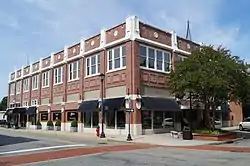Greenville Commercial Historic District (Greenville, North Carolina)
Greenville Commercial Historic District is a national historic district located at Greenville, Pitt County, North Carolina. The district encompasses 51 contributing buildings in the central business district of Greenville. It includes buildings dated from about 1914 to 1952 and notable examples of Greek Revival and Queen Anne style architecture. Located in the district and listed separately are the Pitt County Courthouse (1911) by Milburn, Heister & Company and U.S. Post Office (1913). Other notable buildings include the Proctor Hotel (1911), Montgomery Ward Department Store (1929), Dail-Hodges Building (1919), Blount Building (1924), Greenville Bank and Trust (c. 1915), Smith Electric Building (c. 1933), Greenville Municipal Building (1929) designed by Benton & Benton, Blount-Harvey Department Store (1923), White's Theater (1914), Charles Greene House (1860), and the Robert Lee Humber House (1895).[2][3]
Greenville Commercial Historic District | |
 Blount-Harvey Department Store (1923), Greenville Commercial Historic District, September 2014 | |
  | |
| Location | Roughly bounded by West Third, South Evans and East and West Fifth Sts., Greenville, North Carolina |
|---|---|
| Coordinates | 35°36′42″N 77°22′23″W |
| Area | 25 acres (10 ha) |
| Built | 1914 |
| Architect | Milburn, Heister & Company; Riddick, Burwell et al. |
| Architectural style | Greek Revival, Queen Anne |
| NRHP reference No. | 03000419[1] |
| Added to NRHP | August 21, 2003 |
It was listed on the National Register of Historic Places in 2003, with a boundary increase in 2009.[1]
References
- "National Register Information System". National Register of Historic Places. National Park Service. July 9, 2010.
- Ellen Turco & April Montgomery (December 2002). "Greenville Commercial Historic District" (pdf). National Register of Historic Places - Nomination and Inventory. North Carolina State Historic Preservation Office. Retrieved 2015-02-01.
- Drucilla H. York (May 2009). "Greenville Commercial Historic District (Additional Documentation)" (pdf). National Register of Historic Places - Nomination and Inventory. North Carolina State Historic Preservation Office. Retrieved 2015-02-01.

